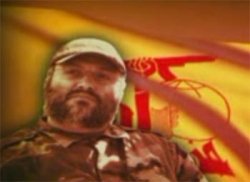Issue 5, spring 2008
https://doi.org/10.70090/PA09RBTS
The February 2008 assassination of paramilitary mastermind Imad Mughniyeh and the July War of 2006 presented challenges to Hizbullah’s capacity as a military organization.[i] Yet the group has attempted to use its media capabilities to translate the two events into political capital in Lebanon and the wider Arab World. While the reach of Hizbullah’s media apparatus has grown with its integration into Internet-based platforms, the group has also become adept in the creation and presentation of its political media content. Hizbullah’s media responses to these specific incidents demonstrate how the group has become skilled at framing key episodes of political violence against the backdrop of historical themes that resonate with the group’s domestic and regional constituencies.
With a narrative that transcends and conflates time and space, the group’s media aim to cultivate Hizbullah’s image as being the vanguard of resistance against perceived Israeli and Western domination. In commemorative videos produced by Al Manar in response to Mughniyeh’s death, this narrative is largely derived from the group’s own unique political culture of militancy and Shiism, while aspects of the group’s prolific media response to the July War of 2006 also incorporate broader nostalgic themes of pan-Arabism. Thus, the group has sought to utilize these events to further reinforce its image of defiance by tapping into themes of revisionism that have timeless currency with its local Shia and greater Arab audiences.
The development of Hizbullah’s media apparatus
Hizbullah’s use of websites as a platform for streaming audio, videos, articles and RSS feeds means that the group is no exception to the wider wave of media format convergence that has accompanied the rise of the internet.[ii] This technological enhancement in media has corresponded with Hizbullah’s gradual expansion of its political reach from a Lebanese resistance organization to an Arab nationalist movement with a regional agenda.[iii]
Between its inception in the mid 1980’s and the Israeli withdrawal from south Lebanon in 2000, Hizbullah’s media apparatus grew from an unlicensed radio station and newspapers, into several websites and the satellite station Al Manar which had existed as a terrestrial broadcaster since 1991.[iv] Since the 2006 conflict, the group’s Internet presence has expanded to over fifteen affiliated websites.[v] Before its embrace of new media Hizbullah initially relied on journals to propagate its message. Its first journal, Al Ahd, was founded in the mid 1980s and was soon followed by other weekly journals.[vi] Print media was followed by three radio stations, which were eventually eclipsed by Al Manar.[vii] More recent advancements in internet technology and production capabilities have allowed for the integration of Nour Radio, Al Manar and its print media through many of the group’s websites,[viii] providing a convergent platform to what was already a robust media presence.
The political goals of Hizbullah’s media program have also evolved over the years. After Al Manar’s inception in 1991, the station enabled Hizbullah to mobilize its local Shia constituency and to erode Israeli support for the occupation of south Lebanon.[ix] Hizbullah also aimed to nationalize its efforts by using its media outlets to appeal to other Lebanese sectarian groups.[x] The airing of combat on the station and websites amplified the effects of Hizbullah’s attrition campaign against the IDF by broadcasting Israel’s battlefield losses on the Internet and television, thus tilting Israeli public opinion towards withdrawal from south Lebanon.[xi]
With the broadening of Hizbullah’s constituency in the Arab world, Al Manar’s broadcasts have evolved in reaction to trends within the local, regional and international contexts.[xii] The increase in Al Manar’s broadcast capability from a local TV station to an international satellite station in May of 2000 coincided with Israel’s withdrawal from south Lebanon.[xiii] During the second Palestinian Intifada in the fall of 2000, Hizbullah sought to capitalize on Al Manar for its newfound regional agenda by declaring that it would provide direct assistance to the Palestinian resistance.[xiv] The goals of Al Manar’s coverage of the Intifada were to bring live coverage of the conflict to Arab households around the world, mobilize widespread support for resistance efforts and, not least, to link Palestinian struggles against Israel with Hizbullah’s own success against the occupation of south Lebanon.[xv]
Subsequently, Al Manar’s popularity amongst the Palestinians of the Occupied Territories has come to rival that of Al Jazeera.[xvi] This enabled Hizbullah to co-opt the Palestinian struggle into its media campaign with Al Manar producing several dramatic documentaries depicting the daily suffering of Palestinians at the hand of the Israelis, including the torturing of Palestinian prisoners.[xvii] Beyond Palestinians, however, Al Manar has only managed to reach out to a niche audience compared to stations like Al Jazeera and Al Arabiya.[xviii]
Hizbullah’s integration of its media with internet technology in recent years has enhanced its ability to reach multiple constituencies.[xix] This is because the presentation of media through convergent platforms allows individuals to access a wide reservoir of content from anywhere at any time, thereby increasing the accessibility of the group’s media.[xx] Additionally, the gradual integration of Hizbullah’s media into platforms such as YouTube also suggest that structural factors inherent to new media convergence, namely the overlap of networks and media spheres, are also facilitating this process. [xxi]
Yet while internet technology has broadened the reach of an already robust media apparatus, scope alone is not sufficient to significantly boost the political utility of Hizbullah’s media. The true cornerstone of Hizbullah’s media strategy is content which frames political violence within a narrative that has currency with both domestic and regional audiences – that of resistance. I will argue that by integrating contemporary events with historical images, sounds and discourses of resistance derived from Shia Islam and pan-Arabism, Hizbullah has capitalized on political violence to advance its political and military goals.
‘Resistance’ as a timeless narrative
Hizbullah has developed politically in both domestic and regional terms since its formative years as an armed resistance to Israel’s occupation of south Lebanon in the 1980s and 90s. As the group has gradually been integrated into mainstream Lebanese politics since entering the parliamentary process in 1992, it has attained influence as a regional player by portraying itself as a pan-Arab resistance, and increasingly so after Israel’s withdrawal in 2000.[xxii] While Hizbullah’s early rhetoric emphasized its roots within Lebanon’s Shia constituency, much of the group’s discourse since the second Palestinian Intifada has contained both Arab nationalist overtones and Lebanese proto-nationalism.[xxiii] Subsequently, the group’s political platform has broadened, allowing it to adapt to the shifting landscape of regional politics.[xxiv]
Hizbullah has consistently positioned itself as a force resisting the actions of Israel and the superpowers, to which they attribute the subjugation and oppression of the Third World.[xxv] Accordingly, Hizbullah’s discourse remains constructed around the notion of resistance that largely stems from its fight against the Israeli invasion and occupation of Lebanese territory. This ideal of defiance against oppressive forces has remained central to Hizbullah’s self-proclaimed mission even after the Israeli withdrawal. [xxvi] The group has adopted Shebaa Farms and other territorial disputes along the Lebanese-Syrian border into its list of grievances to maintain the pretext for armed resistance since Israel’s military presence inside Lebanon has all but vanished.[xxvii] But beyond the territorial disputes, the foundations of Hizbullah’s revisionism can be traced to its Shia-influenced political culture where militancy and religiosity are closely interlinked.
Defiance of oppression in Shia doctrine is an ideal that transcends both time and space as embodied in the story of the death of Imam Hussein Ibn Ali in 680 AD at Karbala. According to Shia interpretations, when given the choice of either submitting to the demands of then Ummayad Caliph Yazid and his army at Karbala, or resisting and suffering imminent death, Hussein chose to fight, even after the loss of his companions and family to Yazid’s army.[xxviii] As a result of his sacrifice, a sense of righteousness is attributed to those who follow in the footsteps of those martyred at Karbala and partake in the symbolic struggle for justice against oppression.[xxix] Slogans derived from the story of Karbala that have become definitive of Shia political Islam such as, “every day is Ashoura and every land is Karbala” and “humiliation is far from us,” suggest that the political ideal of resistance is also an expression of faith that transcends both time and space.[xxx]
The martyrdom of Imam Hussein at Karbala is a reference point around which Hizbullah has framed contemporary issues and events. For example, in his elegy to former Secretary General ‘Abbas al-Mussawi in February of 1992, current Secretary General Hassan Nasrallah compared the assassination of Mussawi and members of his family to that of Hussein and his family at Karbala stating, “As if your bombed and destroyed cortege were Hussein’s tents burning in the desert, as if you were that same Hussein, the commander on the battlefield, Hussein the rebel in the face of oppression and despotism… you, my master, epitomize all that Karbala represented.”[xxxi] More recently, videos broadcast on Al Manar and websites in commemoration of Mughniyeh’s death use imagery from Karbala, where Mughniyeh is referred to as a “Knight of Hussein” arriving on his horse from Karbala to join previous high-profile Hizbullah martyrs in paradise.[xxxii]
The framing of resistance in this manner extends to both Hizbullah’s domestic and regional dealings. For example, during his speech to supporters on Ashoura of 2008, Nasrallah referred to Karbala as an eternal lesson in history, applying it to current domestic and regional political challenges.[xxxiii] He declared that the threat posed by the U.S. and Israel to Palestine, Iraq and Lebanon was like what Hussein faced at Karbala against the followers of Yazid. According to Nasrallah, the Lebanese and the region, like Hussein, find themselves between two choices: to fight and confront the enemy or to give in and surrender to their demands. He asserted their response to this demand today is the same as that of Hussein on the field of Karbala, and as it was in response to the Israeli incursions in 1982 and 2006, “Heyhat mina azzila”, or humiliation is far from us.[xxxiv] [Video 1: Nasrallah’s speech from the day of Ashoura - January 19, 2008]. Accordingly, the juxtaposition of the imagery and language of Karbala with that of the modern Hizbullah resistance is evident in the some of the group’s media. For example see: [Video 2: Karbala then and now: Hayat mina zila]
In addition to being a reference point for understanding the religious aspects of Hizbullah’s defiance, Karbala has helped shape a political culture of resistance that often relies upon framing contemporary events against a backdrop of images, messages and lessons from the past. This technique has been applied to the group’s media efforts that aim to preserve and advance its image of resistance at the organizational and regional levels.
Imad Mughniyeh joins the caravan of martyrs[xxxv]
Hizbullah’s media inspired by the death of Imad Mughniyeh show how the group has employed its resistance media to maintain its image of defiance in the eyes of its predominantly Lebanese Shia support base. Indeed, the mystery surrounding Mughniyeh’s life and activities provided a blank slate for Hizbullah’s media apparatus to mold the myth of Mughniyeh through ceremony, discourse and imagery that frames his death, not as a defeat, but as an omen of victory that is part of a greater history of defiance. This builds on narratives of Hizbullah as a movement based on the sacrifice of martyrs, and the imagery and language that embody the group’s form of political Shia Islam and revisionist militancy.
Imad Mughniyeh, a man whose life remained a mystery following his implication in several terrorist attacks during the 1980s and 1990s, is now being celebrated as “The Backbone of the Resistance” who commanded successful military campaigns for Hizbullah in the July War of 2006 and operations that led to an Israeli withdrawal from south Lebanon in 2000.[xxxvi]Accordingly, his place within the history of the organization has been equated to the group’s founding fathers: Spiritual leader Sheikh Ragheb Harb and the group’s first Secretary General ‘Abbas al-Mussawi.[xxxvii] Mughniyah’s image has subsequently been framed alongside these two previously assassinated leaders, and has been described by some as joining the caravan of these martyrs.[xxxviii]
One factor that has facilitated this depiction of Mughniyeh is the fact that his death came shortly before Hizbullah’s own Islamic Resistance Week holiday. Held in February, Islamic Resistance Week is when Hizbullah mourns its previous founding leaders: spiritual guide Sheikh Ragheb Harb and former Secretary General ‘Abbas al-Mussawi, both of whom were assassinated by Israel.[xxxix] While ceremonies commemorating this week have traditionally taken place on February 16th, the date of Harb and Mussawi’s assassinations in 1984 and 1992, this year the event was held on the 22nd to apparently accommodate Mughniyeh’s inclusion into the festivities.[xl] Al Manar’s coverage of the ceremony closing Islamic Resistance Week, dubbed the “The Omen of the Decisive Victory,” in reference to Mughniyeh’s death, best exemplifies the thematic elements of Hizbullah’s resistance culture. In addition to the imagery depicting Mughniyeh as one of a line of martyrs,[xli] Nasrallah in his speech described Mughniyeh as constituting a key stage of the resistance that followed previous stages embodied by Harb and al-Mussawi. Banners and artwork representing a lineage of martyrs, from Harb to Mughniyeh, were complimented with speeches by the sons of the martyrs, representing the link between the current members of the resistance and the departed.
Perhaps most dramatic was the appearance of Imad Mughniyeh’s alleged son, Jihad, who addressed the crowd dressed in military garb. A teenager, Jihad stated that this was the first time that he has publicly appeared as the son of Mughniyeh. He then addressed Nasrallah stating, “By your name oh father, I say to my father of the martyrs his eminence the Secretary General of Hizbullah, we are with you, we are your children as all children of the martyrs we go along with you wherever you go we will not leave the march, we will not leave our weapons… I am at your service oh Nasrallah!”[xlii] The physical demonstration of the resistance maintaining its course would later appear in the group’s media.
The themes that underscored the Islamic Resistance Week ceremony and Mughniyeh’s funeral service are illustrated in mini-documentaries and video clips aired by Al Manar between programs. One thirty-minute program entitled, Bushra al-Nasr, or “The Omen of Victory,” explains the significance of the month of February to Hizbullah’s struggle against Israel.[xliii] In particular it reminds the viewer how the assassinations of Sheikh Ragheb Harb and ‘Abbas al-Mussawi were followed by revenge attacks in the month of February. According to the narrator, this includes the capturing of two Israeli soldiers in 1986, the collision of two Israeli helicopters in 1997 and the 1999 assassination of IDF General Erez Gerstein. After mentioning Mughniyeh’s death in February of 2008, the viewer then hears an excerpt of Hassan Nasrallah’s speech at Mughniyeh’s funeral stating how the shedding of Mughniyeh’s blood will lead to the eradication of the state of Israel, just as the blood of Harb and Mussawi led to previous Israeli defeats. Thus, the narrative of resistance as a timeless struggle is evoked by integrating the images and sounds associated with Mughniyeh’s death with those of Hizbullah’s other leaders. Allusions to coming retaliatory strikes project this narrative into the future.
Other commemorative clips follow this narrative and demonstrate Al Manar’s dexterity in interlinking lyrical and visual themes. A short music video entitled “They will not sway us…”[xliv] depicts Mughniyeh as a representative of a greater ongoing struggle, which Hizbullah will not to be swayed from. The message is enhanced by synchronization between the lyrics and imagery in the video. The song’s chorus, which states that Hizbullah’s course and determination will never be abandoned, corresponds with stock footage of Mussawi and Harb and shots of Hizbullah fighters and supporters. This is followed by the lyrics, “we are all Imad… we are all Radwan,” at which point the image of Mughniyeh is seen against the backdrop of Hizbullah supporters and soldiers saluting.[xlv] [Video 3: They will not sway us [from our course… our determination]]
Longer video segments commemorating Mughniyeh often present the visual of funeral processions of coffins draped in Hizbullah flags spliced or superimposed with scenes of Hizbullah fighters marching forward in the field, thus maintaining the image of resistance as an ongoing struggle. One such clip entitled, “We swear we will not let them sleep” builds on the idea of Mughniyeh’s death being part of an ongoing battle that will not be abandoned, and stresses the significance of martyrdom and sacrifice to the advancement of the resistance.[xlvi] Here Mughniyeh is referred to as the military planner of the resistance and the leader of every martyr and resistance fighter. He is described as among the greatest of men, and as one who has joined the ranks of Harb and al-Mussawi among the caravan of martyrs. The narrator proclaims that the men of Hizbullah are “lovers of resistance and martyrdom,” and reminds the viewer that the spirit cannot die, and in fact, it is martyrdom of leaders that brings life to movements and nations. [Video 4: We swear we won’t let them sleep]
Other videos that feature intricate eulogies to Mughniyeh utilize similar imagery but go farther to portray Hizbullah’s own militancy in terminology more specific to Shia Islam. [xlvii] This is accomplished by linking Mughniyeh to the epic of Karbala with imagery and language derived from the story along with modern day depictions of the Hizbullah resistance. In “Radwan...Paradise blooms with his [arrival],” Mughniyeh is referred to as a rider on Hussein’s horse from Karbala coming to join the other leaders of the caravan in paradise, namely Sheikh Ragheb Harb and ‘Abbas al-Mussawi.[xlviii] This is accompanied by imagery taken from the epic, such as the narrator claiming that he can hear the neighing of a horse returning from the Euphrates river, a reference to the actions of Hussein’s brother ‘Abbas at Karbala. This is followed by contemporary shots of Hizbullah fighters appearing both vigilant and pious, in prayer and poised for battle. [Video 5: Radwan… Paradise blooms with his [arrival]]
Similarly, in “You have dismounted oh knight of Hussein,” Mughniyeh is not only identified as the commander of all those engaged in the resistance, but also as a departing knight of Hussein whose “sword illuminated a revolution.” Further developing the symbolic value of a knight on his steed, the narrator states that Mughniyeh has dismounted from “ the saddle of triumph to retire to the saddle of martyrdom.” The eulogy concludes with the narrator addressing Mughniyeh stating, “Here [in] Dahyieh, her heart beats with its longing to meet [you] in the ceremonies bidding [you] farewell.” [xlix] Thus, as a character Mughniyeh is used to bring together the imagery of Karbala with that of Hizbullah’s support base in south Beirut. [Video 6: You have dismounted oh Knight of Hussein]
Al Manar’s response to Mughniyeh’s assassination demonstrates that, within a relatively short amount of time, it has been able to execute a prolific media campaign that utilizes intricate themes and presentations of Mughniyeh’s life, death, and newfound importance to reinforce the group’s greater narrative of resistance. This integration of past and present, then, is a key technique for suggesting that Mughniyeh’s sudden death is in fact a harbinger of impending victory. While Hizbullah’s media use a narrative derived from its own political culture to maintain its image in the eyes of its Lebanese constituency, aspects of the group’s media response to the July War of 2006 also appeal to a broader historical narrative of Arab defiance aimed at a wider Arab audience.
The July War of 2006: “The Victory of the Arabs”[l]
While much of Hizbullah’s media campaign surrounding the July War of 2006 targeted its local constituency by portraying itself as the ‘protectors’ of all Lebanon,[li] perhaps the most interesting development surrounding the conflict was the group’s efforts to reach a broader Arab audience. This was done by framing and celebrating the conflict as an Arab victory, and interweaving images of Hizbullah’s armed resistance with nostalgic sounds and images of Arab nationalism. A significant part of Hizbullah’s media effort in the aftermath of the war was aimed at maintaining the momentum of a media campaign that galvanized audiences from across the Arab world, allowing the group to garner support beyond its domestic Shia constituency.[lii] Political outcomes, such as how public support in the region for Hizbullah forced Saudi Arabia and the Gulf regimes into reversing their stances on the group’s actions, provided incentive to maintain this image.[liii]
Playing upon venerable pan-Arab themes, Al Manar repeatedly aired music videos featuring montages of Hizbullah fighters in action synchronized to the original recordings of Nasserist anthems from the 1950s and 60s such as, “Keep the Weapons Ready”[liv] and “God is Great.”[lv] Sung by the legendary Egyptian singer Abdel Halim Hafez in the 1960s, “Keep the Weapons Ready” calls on an audience of revolutionaries to remain steadfast and ready with their weapons – day and night – against the constant threat of a ‘treacherous enemy.’ Throughout the video, Hizbullah soldiers are shown preparing their weapons and taking their positions, concluding with a pair of soldiers manning an anti-aircraft gun awaiting an enemy air attack. Thus, Hizbullah’s rendition combines images of its own vigilance against a lyrical backdrop that harkens back to the days of Egyptian-led Pan Arabism. [Video 7: Keep the Weapons Ready!]
The anthem “God is Great,” made famous during the Suez Crisis of 1956,[lvi] contains similar language and imagery declaring that God is one who comes to the aid of the oppressed and his power is greater than the “deceit of the aggressors” and their weapons.[lvii] In Al Manar’s video adaptation of the anthem, Hizbullah fighters are first depicted parading in sequence to the beat and are then shown in action firing rockets and engaging the ‘enemy.’[lviii] This is followed by images of wounded Israeli soldiers being carried away from battle. Over an instrumental break in the music, one sees video footage of a speech made by Hassan Nasrallah following Israel’s withdrawal from south Lebanon in May of 2000 stating, “[we] confirm here anew that here blood triumphs over the sword, and has indeed triumphed over the sword and defeated it. Here too, blood has broken the chains that bind us, and has humiliated despots and arrogant men.”[lix] Here we see a figurative and literal integration of a pivotal moment in Hizbullah’s history into a greater historical narrative of Arab resistance. [Video 8: God is Great]
The response of Palestinian writer Rashad Abu Shawar to this aspect of Al Manar’s wartime media campaign suggests that this depiction of the conflict resonated throughout a region that has historically been on the receiving end of defeat. In an editorial for the Pan Arab Al-Quds Al-Arabi daily following the conflict, Abu Shawar described how Al Manar’s use of these anthems spoke to a collective Arab sentiment and memory, and intensified Arab conviction in the belief that Lebanon represented the “first line of defense” of a common nation against a common enemy.[lx] In contrast to the July War, he suggests that previous setbacks for Israel during the Yom Kippur War of ’73 and its withdrawal from Lebanon in 2000 were insufficient to discourage what he describes as Israeli oppression, arrogance and greed for Arab territory. He argues that Hizbullah’s armed vigilance – embodied by “Keep the Weapons Ready!” – is what enabled them to defeat the ‘enemy’. Abu Shawar’s commentary demonstrates how, in the aftermath of its ‘victory,’ Hizbullah was presented with an opportunity to further build upon its Arabist credentials.
Continuing with this theme, Al Manar has also produced an hour-long program entitled "A Resistance speaking to the Resistance from an Egyptian point of view."[lxi] The documentary frames the July War as an Arab triumph by having individuals within Egyptian society reflect upon and praise the group’s proclaimed victory. It begins with interviews with Egyptian leaders and fighters from the 1973 Yom Kippur War set against the backdrop of Suez City, a key port city sought by the IDF in its counterattack against Egyptian forces in the conflict.[lxii] Sheikh Hafiz Salama, a leader of the popular resistance in Suez City at that time, praises Hizbullah’s unprecedented military achievements during the war after boasting of his own resistance’s alleged refusal to accept then General Ariel Sharon’s demands for their surrender at the time of the IDF’s siege of the city. Fighters that partook in the city’s defense then recount their ability to withstand an attack from a much larger Israeli force, and praise Hizbullah’s 2006 victory whereby one the men states that the Lebanese force taught Israel “a lesson that it will never forget.” Later news coverage of demonstrations in Egypt from the time of the war is shown, with people praising the accomplishments of Hizbullah and declaring them their brothers, and pledging their solidarity to Hassan Nasrallah and Hizbullah.[lxiii] This is followed by more recent interviews with residents and religious figures of the Imam Hussein neighborhood in Cairo, and Egyptian and Syrian film and television personalities, such as Raghda and Samih al-Sariti, all giving similar commentary. [Video 9: A Resistance Speaking to the Resistance from an Egyptian Point of View]
Hizbullah’s desire to maintain this image as the leader of Arab resistance well after the end of the conflict is apparent in a music video produced by Al Manar to celebrate the first anniversary of the July War entitled, “The Victory of the Arabs.”[lxiv] The video, featuring music performed by the Hizbullah-inspired group Firqat al-Wilaya,[lxv] involved an extensive production period lasting several months.[lxvi] Actors from Syria, Lebanon and Egypt were involved with the project that was filmed in Lebanon, Syria, Egypt and Qatar. Representative of the director’s intention to portray an Arab celebration of Hizbullah’s victory, set designs and backdrops used for the video included those depicting the Syrian front during the Yom Kippur War of 1973, the Pyramids and the Nile of Egypt, as well as landmarks in Lebanon.[lxvii] The video begins with Nasrallah referring to the group’s victory during the July War stating, "As I have always promised you victory, I promise you victory anew,"[lxviii] which is followed by scenes of men, women, and children singing along to the music, and carrying the flags of various Arab states and holding up pictures of Nasrallah. [Video 10: The Victory of the Arabs]
This post-conflict media effort has been aided by a significant upgrade in the internet capabilities of Hizbullah, including the addition of new websites in the wake of the conflict.[lxix] Much of the content that appeared during the war and produced in its aftermath has since been integrated into Hizbullah’s newer and most popular websites, whose audiences are located primarily in other Arab states.[lxx] Much of this content has also appeared on YouTube as well. Overall, much of Hizbullah’s media effort in the aftermath of the July War can be seen as a way for Hizbullah to capitalize upon its increased credibility in the Arab world as a result of its military victory. The group has used its transnational satellite and online media outlets to project pan-Arab styled materials in an effort to boost its appeal to the wider Arab audience.[lxxi] Hizbullah’s fusion of historic sounds and images of the Arab nationalism with their resistance narrative reflects the group’s development into a regional political actor.
Conclusion
Hizbullah’s media responses to the assassination of Imad Mughniyeh and the July War of 2006 illustrate the group’s desire to advance its image as the vanguard of resistance. The various framings of these two events by Hizbullah’s media demonstrate a flexibility that at times portrays the group as a pan-Arab resistance organization, while at others emphasizes the group’s Lebanese Shia history and political culture. The increasing sophistication in situating incidents of political violence within narratives that have domestic or regional political currency is the most significant qualitative achievement of Hizbullah’s resistance media to date. Online distribution, whether on Hizbullah-run websites or hosts such as YouTube, has further enhanced the reach of content made by Al Manar’s production team. While the assassination of Mughniyeh and Israel’s campaign against the group in the July War of 2006 aimed to diminish Hizbullah as a military threat, the group is expanding its ability to tailor its message to various audiences, deliver it on a wider scale, and turn military setbacks into propaganda victories.
Pete Ajemian is a New York-based researcher who has written on issues of terrorism and political violence. He recently completed graduate studies at the University of St. Andrews where his dissertation research examined issues dealing with new media, politics and security in the Arab world. He developed an interest in Arab media over the course of his Arabic language studies in Lebanon and the US.
 Arab Media & Society The Arab Media Hub
Arab Media & Society The Arab Media Hub





